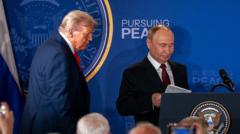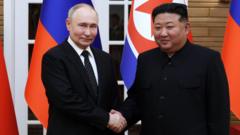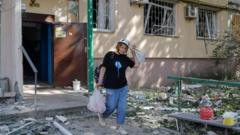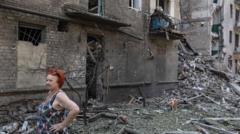A statue of Joseph Stalin, the infamous Soviet leader, has been reintroduced to the Moscow subway after nearly 60 years of absence, marking a contentious revival of his legacy in contemporary Russia. Unveiled this month, the statue showcases Stalin with a contemplative expression, surrounded by enthusiastic workers and children presenting him with flowers.
Restoration or Revision? Stalin's Statue Sparks Debate in Moscow

Restoration or Revision? Stalin's Statue Sparks Debate in Moscow
In a controversial move, a new statue of Stalin in Moscow's subway revives a divisive historic figure amid a climate of war and nationalism.
This restoration, a striking replica of a statue removed during the 1966 de-Stalinization initiative, has drawn mixed reactions from the public. As thousands pass through the stations daily, many choose to honor the figure by leaving floral tributes or capturing the moment in photographs. "We won the war thanks to him," said Liliya A. Medvedeva, a pensioner who views Stalin positively, recalling her father's avoidance of the Gulag during the war years. Her perspective reflects a growing sentiment among some Russians who appreciate nationalist pride and historical vindication during current times of conflict.
However, the presence of this monument has also sparked outrage among those who perceive it as an attempt to gloss over Stalin's violent history and restore a narrative of glory. Critics argue that the Kremlin’s actions signal an unsettling trend of historical revisionism. While open dissent can pose risks in today’s Russia, the complex legacy of Stalin continues to evoke strong emotions and debates over the country’s historical identity.
This modern resurgence of Stalin's image is part of a broader campaign by the Kremlin to celebrate a narrative of Russian triumphs, especially in light of ongoing warfare in Ukraine. As discussions around leadership, memory, and historical interpretation unfold, the reappearance of this controversial figure serves as both an emblem of nostalgia for some and a stark reminder of a brutal past for others. The debate over Stalin's legacy is far from over, illustrating the ongoing struggle within Russian society to reconcile its history with contemporary national identity.
However, the presence of this monument has also sparked outrage among those who perceive it as an attempt to gloss over Stalin's violent history and restore a narrative of glory. Critics argue that the Kremlin’s actions signal an unsettling trend of historical revisionism. While open dissent can pose risks in today’s Russia, the complex legacy of Stalin continues to evoke strong emotions and debates over the country’s historical identity.
This modern resurgence of Stalin's image is part of a broader campaign by the Kremlin to celebrate a narrative of Russian triumphs, especially in light of ongoing warfare in Ukraine. As discussions around leadership, memory, and historical interpretation unfold, the reappearance of this controversial figure serves as both an emblem of nostalgia for some and a stark reminder of a brutal past for others. The debate over Stalin's legacy is far from over, illustrating the ongoing struggle within Russian society to reconcile its history with contemporary national identity.




















